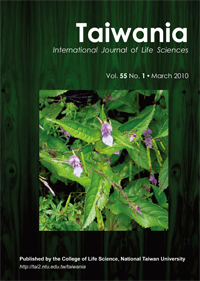Research Paper
Lysophospholipids Attenuate Acetylcholine-evoked Ca2+ Responses in Bovine Chromaffin Cells
Li-Long Lu, Chien-Yuan Pan
Published on: 10 March 2010
Page: 60 - 66
DOI: 10.6165/tai.2010.55(1).60
Abstract
Adrenal medulla chromaffin cells are stimulated by acetylcholine released from sympathetic preganglionic neurons and secret catecholamines into the blood to accommodate short-term stress. Acetylcholine activates nicotinic and muscarinic receptors to elevate the intracellular Ca2+ concentration and causes the secretion of catecholamines. Lysophospholipids in the serum, including sphingosine 1-phosphate (S1P) and lysophosphatidic acid (LPA), are released primarily from immune cells during blood clotting and infection to modulate various physiological activities. To characterize the effects of lysophospholipids on Ca2+ responses in bovine chromaffin cells, cells were loaded with the Ca2+ indicator fura-2, and fluorescence intensity was used to monitor changes in intracellular Ca2+ concentration. Cells treated with 1 μM S1P or LPA for 0, 10, 20, 30, 40, 50, or 60 min were stimulated with acetylcholine (100 μM), muscarine (100 μM), DMPP (10 μM), or high K+ buffer (50 mM KCl) for 5 sec. The results showed that the Ca2+ responses evoked by acetylcholine were significantly inhibited after incubation in LPA or S1P for 20 min. The Ca2+ response evoked by high K+ buffer was not inhibited by S1P pretreatment and was significantly facilitated by LPA pretreatment. Muscarine-evoked Ca2+ responses were slightly attenuated by LPA and S1P pretreatments. Nicotine-evoked responses were inhibited in both LPA- and S1P-pretreated cells. Our findings demonstrate that nicotinic receptors may be the main targets of lysophospholipids in inhibiting acetylcholine-evoked Ca2+ responses.
中文摘要
交感神經節前神經分泌乙醯膽鹼,刺激腎上腺嗜鉻細胞將兒茶酚胺釋放到血液中,以反應短期壓力。乙醯膽鹼活化尼古丁及蕈毒鹼受器,提高胞內鈣離子濃度 ([Ca2+]i) 因而釋放兒茶酚胺。而在血液中,由免疫細胞所分泌的水解磷酸脂 (lysophospholipids, LPLs),包括鞘胺醇1-磷酸鹽 (sphingosine 1-phosphate, S1P) 及溶血磷脂酸 (lysophosphatidic acid, LPA),則會引起許多不同的生理反應。為探討LPLs 對嗜鉻細胞[Ca2+]i 變化的效應,細胞先以鈣離子指示劑Fura-2 標定,以觀察 [Ca2+]i 的變化。再以1 μM S1P 或LPA 處理0、10、20、30、40、50、或60 分鐘後,以乙醯膽鹼 (100 μM)、蕈毒鹼 (100 μM)、DMPP (10 μM)、或高鉀溶液 (50 mM KCl) 刺激5 秒。結果顯示在LPA 或S1P 處理20 分鐘後,乙醯膽鹼所引起的 [Ca2+]i 上升,受到明顯的抑制。然而高鉀溶液所引起的 [Ca2+]i 上升,並不會受到 S1P 前處理的影響,但會被LPA 所增加。蕈毒鹼刺激所引起的反應,僅會受LPLs 稍微抑制;然而以DMPP 活化尼苦丁受器所引起的 [Ca2+]i 反應,則會受到LPA 及S1P 的顯著抑制。這些結果顯示,LPLs 可能主要是透過抑制尼古丁受器,而達到抑制乙醯膽鹼所引起的 [Ca2+]i 上升。
Keyword: Ca2+ channel, G-protein-coupled receptor, lysophosphatidic acid, muscarinic receptor, nicotinic receptor, sphingosine 1-phosphate. 鈣離子通道、G 蛋白連結受器、水解磷酸脂、蕈毒鹼受器、尼古丁受器、鞘胺醇 1-磷酸鹽。


